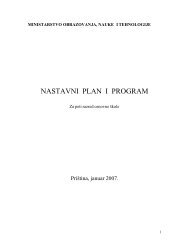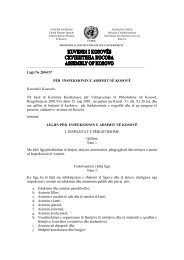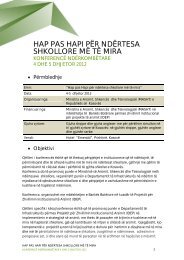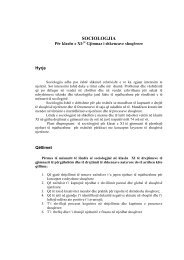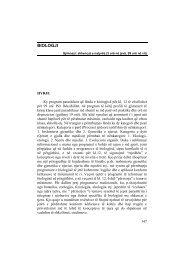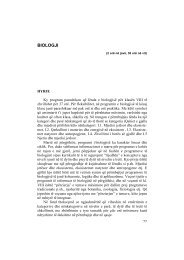Humboldt Kosmos 90/2007: Wissen schafft Entwicklung
Humboldt Kosmos 90/2007: Wissen schafft Entwicklung
Humboldt Kosmos 90/2007: Wissen schafft Entwicklung
Erfolgreiche ePaper selbst erstellen
Machen Sie aus Ihren PDF Publikationen ein blätterbares Flipbook mit unserer einzigartigen Google optimierten e-Paper Software.
<strong>Wissen</strong> <strong>schafft</strong> <strong>Entwicklung</strong> | || From Knowledge to Development <strong>Wissen</strong> <strong>schafft</strong> <strong>Entwicklung</strong> | || From Knowledge to Development<br />
In Nigeria soll sie Mangel ernährung<br />
vorbeugen, in Eu ropa<br />
helfen, einheimische früchte<br />
resistent gegen die folgen<br />
des Klimawandels zu machen.<br />
Odunayo Adebooye erforscht<br />
die Schlangentomate.<br />
Im Gewächshaus schlägt dem<br />
Besucher Feuchtigkeit entgegen<br />
vermischt mit einem eigentümlichen<br />
Aroma. Der intensive<br />
Duft entströmt den Blüten,<br />
Früchten und Blättern von<br />
Trichosanthes cucumerina L., der<br />
Schlangenhaargurke. In ihrer<br />
Heimat im Südwesten Nigerias<br />
nennt man sie Schlangentomate,<br />
weil die reifen Früchte sich<br />
kräftig rot färben und ähnlich<br />
schmecken sollen wie Tomaten.<br />
Im Moment sehen die meisten<br />
Früchte eher aus wie blasse<br />
Gurken. Doch das kann auch<br />
an dem verregneten Sommer in<br />
Deutschland liegen. Denn hier,<br />
fernab der afrikanischen Sonne,<br />
wachsen rund hundert Pflanzen<br />
im Gewächshaus des Fachbereichs<br />
Gartenbauwissenschaft im<br />
Institut für Nutzpflanzenwissenschaften<br />
und Ressourcenschutz<br />
(INRES) der Universität Bonn.<br />
Hierher gebracht und aufgezo gen<br />
hat sie der nigerianische Gar -<br />
tenbauwissenschaftler Odunayo<br />
Adebooye. Er will mehr über<br />
die bislang kaum erforschte und<br />
in seiner Heimat als eine Art<br />
Tomate für arme Leute gering<br />
geschätzte Pflanze herausfinden.<br />
Denn Trichosanthes cucumerina<br />
DIE WuNDErpflANzE<br />
ThE MIrAclE plANT<br />
In Nigeria it is supposed to prevent<br />
malnutrition, in Europe<br />
to help make indigenous fruit<br />
resistant to the consequences<br />
of climate change. Odunayo<br />
Adebooye is researching into<br />
the snake tomato.<br />
The humidity in the hothouse<br />
hits you in the face, mingled<br />
with a strange aroma. The intensive<br />
smell exudes from the<br />
flowers, fruit and leaves of the<br />
Trichosanthes cucumerina L., the<br />
snake gourd. Where it hails from<br />
in south western Nigeria it is<br />
also known as the snake tomato<br />
because the ripe fruit is a rich<br />
red colour and supposedly tastes<br />
like tomatoes. At the moment,<br />
most of the fruit resembles pale<br />
cucumbers. But that could be<br />
due to the rainy summer we’ve<br />
had in Germany, because there<br />
are a hundred of them growing<br />
far from the African sun in the<br />
hothouse belonging to the Division<br />
of Horticultural Sciences at<br />
the Institute of Crop Science and<br />
Resource Conservation (INRES)<br />
at Bonn University. They were<br />
brought here and cultivated by<br />
the Nigerian horticultural scientist,<br />
Odunayo Adebooye. He<br />
wants to discover more about<br />
this little-researched plant which<br />
in his own country is dismissed<br />
as a kind of poor man’s tomato.<br />
The reason for this is that<br />
Trichosanthes cucumerina is really<br />
potent. It has far more vitamin C,<br />
vitamin A, raw proteins, essential<br />
hat es in sich. Ihr Gehalt an Vitamin C, Vitamin A, Rohproteinen,<br />
essentiellen Aminosäuren und Kalzium ist dem der bislang<br />
be vorzugten und weiter verbreiteten Tomate und manch anderen<br />
Gemüsesorten weit überlegen. Zugleich stellt sie weniger Ansprüche<br />
an den Boden und ist daher ideal für den humusarmen Grund,<br />
dem die Farmer in Südwestnigeria sonst nur mit Mühe Gemüse<br />
abtrotzen. Als Grundnahrungsmittel und Vitaminlieferant könnte<br />
sie Mangelernährung vorbeugen und etwa dafür sorgen, dass die<br />
vor allem bei Kindern häufigen Augenkrankheiten in der Region<br />
weniger würden. Eine zusätzliche Einkommensquelle für die<br />
Bauern wäre ihr Anbau zudem.<br />
Zunächst aber müsste mehr über die Schlangentomate bekannt<br />
sein und ihre Verwendung populärer gemacht werden. Wenn es<br />
einen idealen Botschafter hierfür gibt, dann ist es Adebooye. Die<br />
Pflanzen, die hier in Bonn ein halbes Gewächshaus füllen und<br />
bis unter die Decke ranken, sind seine Babys. Der Vaterstolz ist<br />
nicht zu übersehen, wenn Adebooye mit leuchtenden Augen die<br />
Pflanzen präsentiert: „Riechen Sie das Aroma? Sehen Sie sich<br />
diese Frucht an. Hier wird sie nur so groß wie eine Gurke, doch<br />
in Nigeria kann sie bis zu einem Meter lang werden!“ Wenn der<br />
schlaksige Afrikaner mit raschem Schritt in Turnschuhen durch<br />
das Institut und die Gewächshäuser federt und Kollegen trifft,<br />
merkt man, dass seine Begeisterung ansteckend ist. Jeder kennt<br />
Adebooye und seine Pflanzen. Die Fangemeinde der Schlangentomate<br />
wächst bereits.<br />
Das Bonner Klima überlisten<br />
Dabei war es anfangs nicht einfach. Mochte Bonn, anders als Adebooyes<br />
Heimatinstitut, die nötigen technischen Voraussetzungen<br />
für die Erforschung der optimalen Kultur- und Anbaubedingungen<br />
der Wunderpflanze bieten – der Schlangentomate fehlte<br />
ihr natürliches Umfeld. Die aus Nigeria mitgebrachten Samen<br />
wollten nicht keimen. Selbst im Gewächshaus war der Boden zu<br />
kalt. Also bauten die deutschen Kollegen eine spezielle Apparatur,<br />
eine Art Fußbodenheizung, die die Anzuchterde auf 25 bis 30<br />
Grad Celsius erwärmt. Im wohlig temperierten Erdreich keimten<br />
die Pflanzen sogar schneller als daheim und wuchsen mit Hilfe<br />
künstlicher, intensiverer Lichteinstrahlung zügiger weiter. Doch<br />
das nächste Problem wartete bereits. Die in Deutschland heimischen<br />
Insekten konnten die Blüten nicht bestäuben. In Nigeria<br />
besorgen dies bestimmte Schmetterlingsarten. Adebooye musste<br />
die Blüten mechanisch befruchten und die Pollen mit einem Pinsel<br />
übertragen, was nicht einfach war. Wahrscheinlich können nur<br />
Agrarwissenschaftler oder allenfalls Rosenzüchter wirklich das<br />
Glücksgefühl nachvollziehen, das sich einstellte, als die Mühen<br />
endlich zum Ziel führten und die ersten Früchte sprossen.<br />
Vieles, was für den Anbau und die Popularisierung der Pflanze<br />
wichtig ist, hat Adebooye in Bonn herausgefunden und mit<br />
wissenschaftlich fundierten Daten unterlegt. Er weiß, welche<br />
amino acids and calcium than the more popular and more widespread<br />
tomato and various other vegetables. At the same time,<br />
it is less demanding as far as soil is concerned and thus ideal for<br />
ground lacking humus such as the sort on which the farmers in<br />
south western Nigeria are forced to try and cultivate their vegetables.<br />
As a basic foodstuff and vitamin provider it could prevent<br />
malnutrition and help fight the eye diseases which are particularly<br />
prevalent amongst children in the region. And the cultivation<br />
itself would be a further source of income for farmers.<br />
However, first of all, more has to be known about the snake<br />
tomato, and more people have to be prepared to use it. If anyone<br />
is an ideal ambassador for this it is Adebooye. The plants filling<br />
half the hothouse here in Bonn and reaching right up under the<br />
roof are his babies. His fatherly pride is obvious when he presents<br />
his plants, his eyes shining, “Can you smell the aroma? Just look at<br />
this fruit. Here it only gets as big as a cucumber, but in Nigeria it<br />
can grow to a length of one metre!” As the lanky African in trainers<br />
bounces speedily through the institute and hothouses, meeting<br />
colleagues along the way, it becomes apparent that his enthusiasm<br />
is contagious. Everyone knows Adebooye and his plants.<br />
The snake tomato fan club is increasing in numbers.<br />
Outwitting the Bonn climate<br />
Yet at the beginning it wasn’t so easy. Even though Bonn, by<br />
contrast with Adebooye’s institute at home, had all the necessary<br />
technical prerequisites for investigating the optimum crop<br />
and growing conditions for the miracle plant, the snake tomato<br />
missed its natural habitat. The seeds brought from Nigeria just<br />
didn’t want to germinate. Even in the hothouse the soil was too<br />
cold. So German colleagues built some special apparatus, a kind<br />
of under-floor heating system, to increase the temperature of the<br />
cultivation soil to 25 to 30 degrees Celsius. In the well-tempered<br />
earth the plants germinated even quicker than they do at home,<br />
and with the aid of artificial, more intensive light irradiation grew<br />
faster, too. However, the next problem was lurking just around<br />
the corner. Native German insects couldn’t pollinate the flowers.<br />
In Nigeria this is the task of certain types of butterfly. Adebooye<br />
had to pollinate the flowers mechanically, transferring the pollen<br />
with a brush which wasn’t easy. Probably only agricultural scientists<br />
or at best rose-growers can really imagine the utter happiness<br />
of seeing one’s labour rewarded at last and the first fruit actually<br />
sprouting.<br />
In Bonn, Adebooye has discovered a lot of things which are<br />
important for cultivating and popularising the plant and has<br />
supported them with scientifically-sound data. He knows which<br />
minerals the ideal soil has to contain; he knows the concentration<br />
of the various nutrients which make the fruit so attractive from<br />
a nutritional physiological point of view. He knows how much<br />
sunlight the plant needs for optimum growth and that it is not<br />
20 <strong>Humboldt</strong> kosmos Sonderausgabe 2008<br />
21




